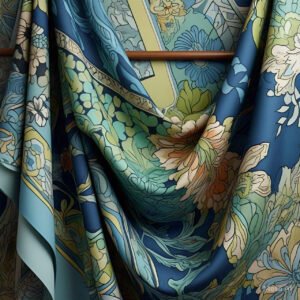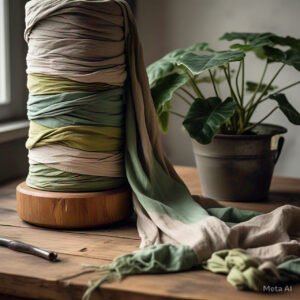What are textile designs?
Textile design involves crafting patterns, textures, and structures onto fabrics to make them aesthetically pleasing and purposeful. It plays a pivotal role in the fashion, home goods, automotive, and industrial sectors. Textile fabric design works with diverse materials, weaving techniques, dyeing processes, and digital technologies to conceive novel, stylish, and practical fabric solutions.
Across millennia, textile designs have evolved from ancient hand-woven cloths and natural colourants to contemporary digital textile printing and intelligent textiles. Traditional methods such as batik, ikat, and jacquard weaving still impact modern fabric motifs, but technological progress has allowed for more exactness, personalization, and efficiency in material production.

Environmental Protection in Textiles: Consumer Demand for Eco-Friendly Materials
As people raise concern for the planet, shoppers desire more sustainable choices in all aspects of life—including fabrics. The textile design industry, once notorious for its large carbon footprint, is undergoing a transformative shift toward eco-friendly materials and production methods that respect the environment.
Why Environmental Stewardship Matters in Textiles
Traditional manufacturing of synthetic fabrics, such as polyester and nylon, releases microplastics, harming aquatic animals and polluting waterways. Additionally, conventional dyeing consumes vast amounts of water while introducing toxic chemicals into rivers and ecosystems. Customers become increasingly aware of these environmental hazards, prompting them to search for ethical, biodegradable, and recyclable textile options.
Innovative Eco-Friendly Techniques in Fabric Production
To address these challenges, textile producers embrace natural materials like cotton, hemp, linen, and bamboo, which require fewer resources to cultivate and process. Moreover, technological breakthroughs such as closed-loop manufacturing (seen in Tencel production) and waterless dyeing significantly cut waste. Sustainable alternatives like fabric from recycled plastic bottles or agricultural waste also gain popularity, proving innovation and environmental care can synergize.

The Future of Eco-Conscious Textiles
As regulations tighten and buyer preferences evolve, brands that fail to adapt to sustainability trends risk losing relevance. Many companies now display certifications like GOTS and OEKO-TEX, signaling their commitment to environmentally sound manufacturing. Environmental protection is no longer optional—it is becoming standard practice across the industry.
Bold Graphics Make a Comeback: The Resurgence of Vibrant Motifs
While understated tones dominated the preceding years, striking prints are powerfully re-emerging. These expressive textile designs defiantly oppose the muted aesthetics of past trends, with radiant hues and intricate layers that demand attention.
Maximalist Prints Defined
Vibrant colour spectra of stark contrast characterise the maximum in fabrics: nuanced designs that showcase ingenuity, geometric patterns or oversized florals, and Whimsical mixes that indulge individuality.
Maximalist prints give creators freedom, using textiles as storytelling canvases. From psychedelic swirls emulating the 70s to graphics inspired by urban art, these daring designs nurture uniqueness and creativity.
Maximise Personality in Attire and Decor
For fashion, maximalist prints define statement pieces—flowing dresses, printed blazers, and eye-catching add-ons. Meanwhile, home decor embraces these vivid designs through wallpaper, upholstery, and area rugs to immerse spaces. Dopamine dressing has also fuelled this movement by using hues that uplift moods.
Why Consumers Favor Maximalist Styles
In uncertain times, bold prints provide an escape through joy and life. They allow self-expression, heritage, and inventiveness through personalized fashion and interiors that energize living spaces.
Digital Advancements Unlock Customization Potential
Digital transformation has revolutionized textile design manufacturing, unlocking customized, on-demand possibilities. As shoppers demand personalised options, digital tools provide unparalleled design flexibility.
How Digital Printing is Altering Fabrics
Unlike traditional methods, digital textile printing directly imprints intricate patterns and photorealistic designs onto fabrics. This process:
While digital fabrication reduces resource usage, it also enables innovative design. 3D modeling visualization allows creators to experiment freely before manufacturing, lowering waste and quickening production timing.

Artificial intelligence also modernizes patterns and predicts emerging styles. Algorithmically generated complex motifs surpass what’s hand-made. Simultaneously, virtual prototyping cuts material use and speeds time-to-market cycles.
The Future of Digital Textiles
Now, barriers to entry into textile designs art are lower than ever before. Independent artists and brands can produce small customized batches, making fabrics more inclusive and exploring new aesthetics.
Some prefer understated serenity over maximal stimulation. This movement emphasized solitary hues, tactile weaves, and minimal motifs, conveying stillness and sophistication.
As urban life accelerates, many seek tranquil spaces. Textiles with subdued earth tones, delicate gradients, and fine geometric patterns offer solace in apparel and interiors.
The palettes comprise soft grays, off-whites, and faint pastels. Woven textures, raised designs, and matte finishes add depth without distraction. Faint line prints and fading shades maintain visual simplicity.
Scandinavian home fashions exemplify this aesthetic through clean contours and neutral palettes, crafting classical refinement.
Technology and fashion progressively intersect, providing interactive materials that enhance our experiences. Smart textiles bridge this gap between innovation and individuality.
What Are Smart Textiles?
Smart textiles integrate electronics, nanotechnology, or responsive materials into the fabric, enabling features like temperature regulation through self-warming fabrics, health monitoring with textiles tracking heart rate, and color-changing using thermochromic technology.
The Future of Wearable Tech in Textiles
From sportswear enhancing performance to medical textiles observing health, smart fabrics will reshape beyond the fashion industries. Whether alerting about vitals or keeping athletes cool, these interactive innovations will drive the wearable revolution forward.
Cultural Fusion: Global Inspirations in Textile Designs
As globalization connects cultures, textile designs draw from diverse heritages, celebrating Indigenous crafts and artistry. Examples include Indonesian ikat weaving, Indian block printing, Ghanaian kente cloth, and Japanese shibori dyeing techniques. Textiles become storytellers by merging traditions with modern designs, preserving identities, and adapting to contemporary trends.
also read: Manufacturing companies in Pakistan
The Glamour of Metallic and Mirrored Fabrics
Shiny, reflective textiles command fashion runways and interior design, symbolizing luxury and futuristic elegance. Metallic and mirrored fabrics create high-impact, dramatic looks often seen in space-age jackets, futuristic gowns, mirrored furniture, and reflective curtains. Playing with light and movement, these fabrics generate a sense of depth and grandeur.
Conclusion
Textile designs is a dynamic and ever-evolving field shaped by creativity, technology, and shifting consumer demands. The top trends show that the industry embraces sustainability and innovation, from eco-friendly fabrics to smart textiles and cultural blending. Whether through bold maximalist prints, subtly understated monochrome patterns, or high-shine metallic fabrics catching the light, designers push boundaries to craft textiles that delight the eyes and serve real needs.
As the planet shrinks and technology progresses, melding past and future will continuously rework the textile trade. Whether an artist, entrepreneur, or aficionado, keeping tabs on shifts opens new wellsprings of vision and impacts how cloth is created.
